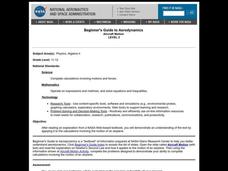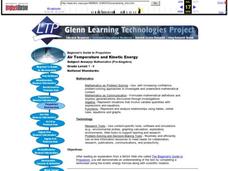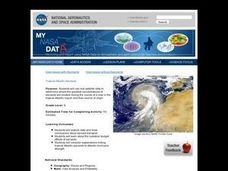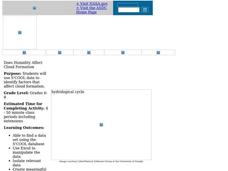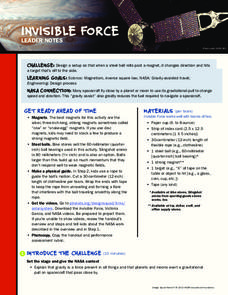Curated OER
Aircraft Motion
Students, after reading an explanation from a NASA Web-based textbook, demonstrate an understanding of the text by applying it to the calculations involving the motion of an airplane.
Curated OER
Airplane Parts/Functions Problem Sets
Students label and describe the functions of the parts of an airplane. They access a NASA Web-based textbook and read a series of lessons before labeling the parts of an airplane.
Curated OER
Dimensional Analysis Problem Set
Students, after studying various pages of a NASA Web-based textbook, use dimensional analysis to verify actual aeronautic equations.
Curated OER
Cruising Aircraft and Balanced Forces
Pupils, after reading an explanation from a NASA Web-based textbook, demonstrate an understanding of the text by applying it to questions involving cruising aircraft and balanced forces.
Curated OER
Trouble in the Troposphere
Students create graphs using NASA data, compare ozone levels of several U.S. cities, analyze and evaluate the data and predict trends based on the data, and discuss and describe how human activities have modified Earth's air quality.
Curated OER
Air Temperature and Kinetic Energy
Learners use a NASA website do activities which help them better explain how air temperature and kinetic energy are related to aircraft propulsion.
Curated OER
Troical Atlantic Aerosols
Students explore the effect aerosols have upon he weather and climate. They observe NASA satellite images to explore and draw conclusions about aerosol transport. From studying the images, students track the path of aerosols. They...
Curated OER
Trouble in the Troposphere
Students Use data sets from MY NASA DATA to produce graphs comparing monthly and yearly ozone averages of several U.S. cities. They analyze and evaluate the data and predict trends based on the data. In addition, they discuss and...
Curated OER
Paper Airplane Activity
Ninth graders select and build one of five different paper airplane designs and test them for distance and for time aloft. Part of this activity is designed to explore NASA developed software, FoilSim, with respect to the lift of an...
Curated OER
Center of Gravity Problem Set
Pupils read a NASA Web-based text, then demonstrate an understanding of the text by using it to complete an activity on the center of gravity of a commercial cargo airplane.
Curated OER
Forces in a Climb
Students use a NASA website to use a given formula to find acceleration and distance after a specific time and how it relates to engine propulsion.
Curated OER
Does Humidity Affect Cloud Formation?
Young scholars use NASA's S'COOL database to identify factors that affect cloud formation.
Curated OER
The KAO Telescope
Students explore the basic principles of the operation of the NASA's KAO telescope. They construct a simplified model of it using film canisters and other everyday objects. Step by step directions are included in plan.
Curated OER
NASA Glenn Research Center Mission : High-Speed Civil Transport (HSCT)
Students use World Wide Web resources to identify the problems and advantages of high-speed transportation. They download files and graphics and incorporate them into a word processed report.
Curated OER
Team Moon
Students read "Team Moon: How 400,000 People Landed Apollo 11 on the Moon," by Catherine Thimmesh. They watch portions of the movie "Apollo 13." Students use the internet and the attached study guide to discover specific information...
PBS
Invisible Force
Investigate invisible forces. Young engineers design a setup that changes the direction of a steel ball using a magnetic force. The purpose of the setup is to model the gravitational pull of spacecraft by planetary bodies.
NASA
Rover Races
Operating a vehicle remotely can be difficult, especially when the vehicle is on another planet. Young engineers get a feel for some of the real-world challenges as they work to program their rovers (blindfolded group members) through an...
Curated OER
What Do I Wear Out Here?
First graders identify the components of a modular spacesuit. In this astronaut clothing lesson, 1st graders discuss the importance of appropriate clothing for working in space. Students define the term modular and explore an Internet...
Alabama Department of Archives and History
America in Space: German Voices from Huntsville, Alabama
Project Paperclip, the Redstone Arsenal, and the Huntsville Space Center are all featured in a resource that investigates the contributions of Dr. Werner von Brawn and other German scientists to the US space program. Working individually...
PBS
Light Curves of Kepler's First Five Discoveries
The Kepler missions discovered and confirmed more than 2,650 exoplanets to date. A video shares the data from the first five discoveries. It provides graphs and diagrams to put each discovery in perspective to help scholars discuss the...
PBS
Data Plots of Exoplanet Orbital Properties
Scientists discovered the first exoplanet in 1995 and by early 2018, they confirmed the existence of more than 3,700—that's a lot of data! As part of the PBS 9-12 Space series, scholars interpret data about exoplanets. They compare...
American Institute of Physics
Meet Four Pioneering African American Astronauts
An out-of-this-world resource introduces young scientists to four African American astronauts: Michael P. Anderson, Ronald E. McNair, Guion S. Bluford Jr., and Jeanette J. Epps. Groups read biographies of these individuals and prepare...
Curated OER
757 Glider Kit
Students work together to complete a 757 Glider kit. They use a GPS to discover how it operates in all weather landings. They complete different obstacles with the glider as well.
Curated OER
Deep Impact Comet On A Stick
Students investigate the concept of a comet. They construct a model of a comet. The design is done using the same thoughts of an engineer. Students work together to discuss the strengths and weaknesses of the comet models. If the model...
Other popular searches
- Nasal Passages
- About Nasa
- Nasa Planets
- Nasa Robots
- Nasa Lesson Math
- Nasa Aircraft
- Nasa Materials
- History of Nasa
- Nasa Lesson Plans
- Nasa Web Based Textbook
- Nasa Aurora
- Contributions of Nasa


